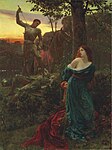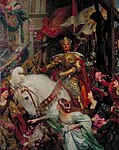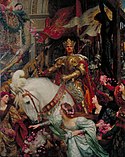Frank Bernard Dicksee
Sir Francis Bernard Dicksee, mer känd som Frank Dicksee, född 27 november 1853, död 17 oktober 1928, var en brittisk konstnär.
Frank Dicksee var son till konstnären Thomas Francis Dicksee, och hans farbror John Robert Dicksee var också målare. Han växte upp i Fitzroy Square i London.[1] Först studerade han under sin far men sedan började han vid Royal Academy Schools där hans lärare var John Everett Millais och Frederic Leighton.[2] Dicksee började ställa ut 1876,[3] och fick mer uppmärksamhet efter att Tate Gallery köpte hans målning Harmony i slutet av 1870-talet. År 1881 blev han associate i Royal Academy, år 1891 fullvärdig akademiledamot och 1924 utsågs han till akademins ordförande.[2]
Dicksee vann berömmelse med sina bilder med romantiska ämnen som motiv ur Arthursagan, Tristan och Isolde och andra medeltidsdikter, Dantes Divina commedia med mera. Han blev även känd för sina eleganta damporträtt.[3]
Galleri
Romeo and Juliet, 1884
Chivalry, 1885
The Funeral of a Viking, 1893
The Mirror, 1896
The Two Crowns, 1900
La Belle Dame sans Merci, ca 1901
Portrait of the Artist's Niece, Dorothy, 1917
Referenser
- ^ ”Fitzroy Square”. Survey of London: Volume 21, the Parish of St Pancras Part 3: Tottenham Court Road and Neighbourhood. London County Council, via British History Online. ursprungligen 1949. https://www.british-history.ac.uk/survey-london/vol21/pt3/pp52-63. Läst 13 november 2020.
- ^ [a b] ”Sir Frank Dicksee”. The Collection: Art Gallery NSW. The Art Gallery of New South Wales. https://www.artgallery.nsw.gov.au/collection/artists/dicksee-sir-frank/. Läst 13 november 2020.
- ^ [a b] Svensk uppslagsbok. Malmö. 1931
Media som används på denna webbplats
Sir Frank Bernard Dicksee (1853 – 1928), an English Victorian painter and illustrator
Representing the famous balcony scene from Romeo and Juliet.

















